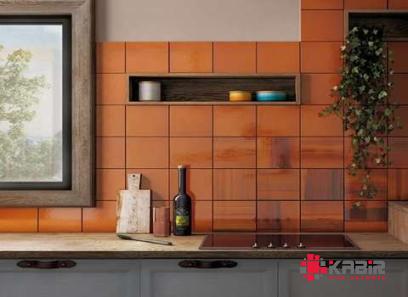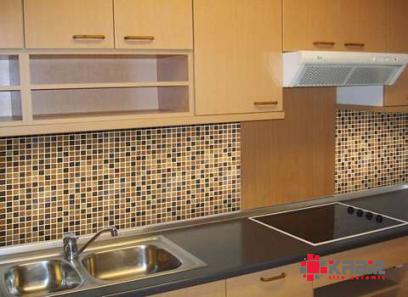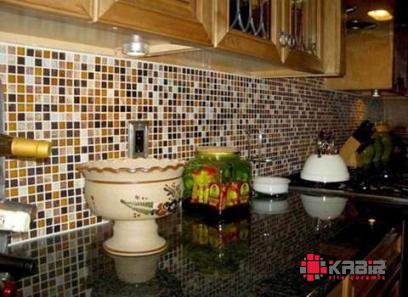In the realm of interior design, the kitchen holds a special place as the heart of the home. It is where families gather, meals are shared, and memories are made. Every detail in the kitchen contributes to its overall ambiance and functionality, and one element that can truly transform the space is a glass tile backsplash. Glass tile backsplashes have gained popularity in recent years for their versatility, durability, and aesthetic appeal. In this comprehensive guide, we will explore the various aspects of glass tile backsplashes, from their benefits and types to installation tips and design ideas. Benefits of Glass Tile Backsplash 1. Elegance and Style: Glass tile backsplashes add a touch of elegance and sophistication to any kitchen. The sleek and glossy surface of glass tiles reflects light, making the space appear brighter and more spacious. Whether you prefer a modern, minimalist look or a classic, timeless design, glass tiles offer endless possibilities for customization.

.
 2. Easy Maintenance: Glass tiles are non-porous, which means they are resistant to stains, mold, and mildew. Unlike other materials like natural stone or ceramic tiles, glass tiles do not require sealing and are easy to clean with a mild detergent and water. This makes them an ideal choice for busy kitchens where spills and splatters are common. 3. Durability: Despite their delicate appearance, glass tiles are surprisingly durable and long-lasting. They are resistant to heat, scratches, and fading, making them suitable for high-traffic areas like the kitchen. Glass tiles are also less prone to cracking and chipping compared to ceramic or porcelain tiles. 4. Versatility: Glass tiles come in a wide range of colors, shapes, sizes, and finishes, allowing you to unleash your creativity and design a backsplash that suits your personal style. Whether you prefer a bold pop of color, a subtle shimmer, or a mosaic masterpiece, there is a glass tile option to meet your design needs. Types of Glass Tiles 1. Clear Glass Tiles: Clear glass tiles are transparent and provide a seamless look that allows the underlying wall to show through. They are perfect for creating a modern and open feel in the kitchen. Clear glass tiles are often used as a border or accent to highlight other design elements in the space. 2. Frosted Glass Tiles: Frosted glass tiles have a matte finish that diffuses light and creates a soft, subtle effect. They are ideal for adding texture and depth to the backsplash without overwhelming the space. Frosted glass tiles are available in a variety of colors and can be used to create a monochromatic or multicolored design.
2. Easy Maintenance: Glass tiles are non-porous, which means they are resistant to stains, mold, and mildew. Unlike other materials like natural stone or ceramic tiles, glass tiles do not require sealing and are easy to clean with a mild detergent and water. This makes them an ideal choice for busy kitchens where spills and splatters are common. 3. Durability: Despite their delicate appearance, glass tiles are surprisingly durable and long-lasting. They are resistant to heat, scratches, and fading, making them suitable for high-traffic areas like the kitchen. Glass tiles are also less prone to cracking and chipping compared to ceramic or porcelain tiles. 4. Versatility: Glass tiles come in a wide range of colors, shapes, sizes, and finishes, allowing you to unleash your creativity and design a backsplash that suits your personal style. Whether you prefer a bold pop of color, a subtle shimmer, or a mosaic masterpiece, there is a glass tile option to meet your design needs. Types of Glass Tiles 1. Clear Glass Tiles: Clear glass tiles are transparent and provide a seamless look that allows the underlying wall to show through. They are perfect for creating a modern and open feel in the kitchen. Clear glass tiles are often used as a border or accent to highlight other design elements in the space. 2. Frosted Glass Tiles: Frosted glass tiles have a matte finish that diffuses light and creates a soft, subtle effect. They are ideal for adding texture and depth to the backsplash without overwhelming the space. Frosted glass tiles are available in a variety of colors and can be used to create a monochromatic or multicolored design.
..
 3. Mosaic Glass Tiles: Mosaic glass tiles are small, individual pieces that are mounted on a mesh backing for easy installation. They come in a wide range of colors, shapes, and patterns, allowing you to create intricate designs and custom motifs. Mosaic glass tiles are a popular choice for adding visual interest and personality to the kitchen. 4. Recycled Glass Tiles: As eco-conscious consumers seek sustainable alternatives, recycled glass tiles have become a popular choice for kitchen backsplashes. These tiles are made from recycled glass bottles and other glass materials, making them an environmentally friendly option. Recycled glass tiles come in a variety of colors and finishes, adding a unique and eco-friendly touch to your kitchen. Installation Tips 1. Surface Preparation: Before installing a glass tile backsplash, ensure that the wall surface is clean, dry, and smooth. Remove any existing tile, paint, or wallpaper and repair any cracks or imperfections in the wall. It is essential to create a flat and even surface for the glass tiles to adhere properly. 2. Adhesive Selection: Choose a high-quality adhesive specifically designed for glass tiles to ensure a strong and durable bond.
3. Mosaic Glass Tiles: Mosaic glass tiles are small, individual pieces that are mounted on a mesh backing for easy installation. They come in a wide range of colors, shapes, and patterns, allowing you to create intricate designs and custom motifs. Mosaic glass tiles are a popular choice for adding visual interest and personality to the kitchen. 4. Recycled Glass Tiles: As eco-conscious consumers seek sustainable alternatives, recycled glass tiles have become a popular choice for kitchen backsplashes. These tiles are made from recycled glass bottles and other glass materials, making them an environmentally friendly option. Recycled glass tiles come in a variety of colors and finishes, adding a unique and eco-friendly touch to your kitchen. Installation Tips 1. Surface Preparation: Before installing a glass tile backsplash, ensure that the wall surface is clean, dry, and smooth. Remove any existing tile, paint, or wallpaper and repair any cracks or imperfections in the wall. It is essential to create a flat and even surface for the glass tiles to adhere properly. 2. Adhesive Selection: Choose a high-quality adhesive specifically designed for glass tiles to ensure a strong and durable bond.
…
 Thinset mortar is commonly used for glass tile installation, as it provides excellent adhesion and flexibility. Apply the adhesive evenly on the wall using a trowel, taking care to follow the manufacturer’s instructions. 3. Grout Application: Once the glass tiles are set in place, it is time to apply grout to fill the gaps between the tiles. Choose a grout color that complements the glass tiles and enhances the overall design. Use a grout float to spread the grout evenly and press it into the joints. Wipe off excess grout with a damp sponge before it dries. 4. Sealing: While glass tiles are non-porous and resistant to stains, it is recommended to seal the grout to protect it from moisture and dirt. Use a grout sealer to seal the grout lines and prevent discoloration or mildew growth. Regular maintenance and sealing will ensure that your glass tile backsplash remains beautiful and functional for years to come. Design Ideas 1. Monochromatic Elegance: Create a sophisticated look with a monochromatic glass tile backsplash in shades of white, gray, or black.
Thinset mortar is commonly used for glass tile installation, as it provides excellent adhesion and flexibility. Apply the adhesive evenly on the wall using a trowel, taking care to follow the manufacturer’s instructions. 3. Grout Application: Once the glass tiles are set in place, it is time to apply grout to fill the gaps between the tiles. Choose a grout color that complements the glass tiles and enhances the overall design. Use a grout float to spread the grout evenly and press it into the joints. Wipe off excess grout with a damp sponge before it dries. 4. Sealing: While glass tiles are non-porous and resistant to stains, it is recommended to seal the grout to protect it from moisture and dirt. Use a grout sealer to seal the grout lines and prevent discoloration or mildew growth. Regular maintenance and sealing will ensure that your glass tile backsplash remains beautiful and functional for years to come. Design Ideas 1. Monochromatic Elegance: Create a sophisticated look with a monochromatic glass tile backsplash in shades of white, gray, or black.










Your comment submitted.